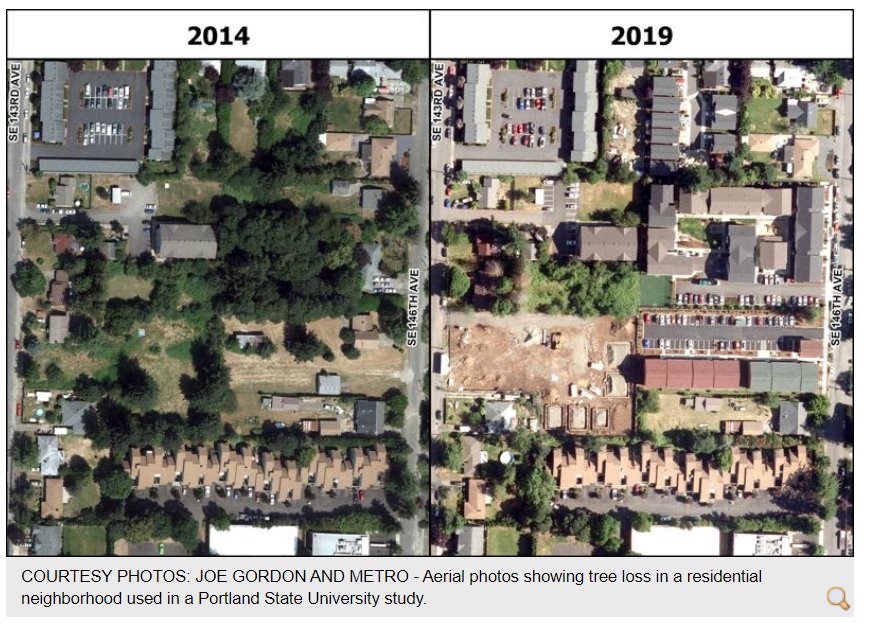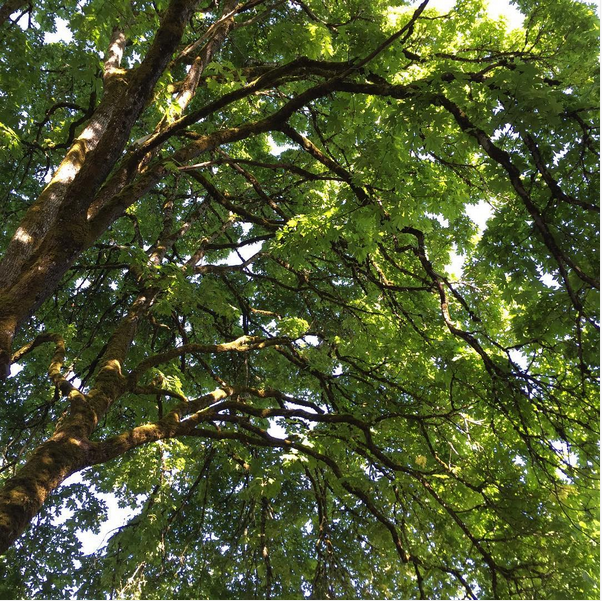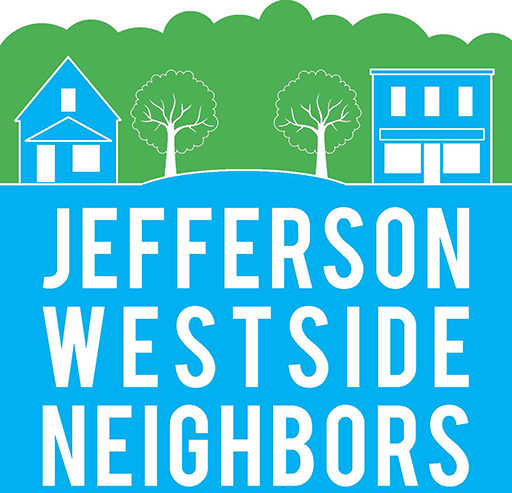Volunteers Needed!
The Jefferson Westside Neighbors area is defined by its many, and often mature large, street trees. It may surprise you that tree canopy cover in Eugene is below the national average and declining by about 1% a year. Increasing citywide canopy cover to 30% (currently it is 23%) is one of six urban forestry goals outlined in Eugene’s Climate Action Plan 2.0. Mature street trees help define our community culture. There are many benefits of trees: Trees help mitigate global warming and save energy; help mitigate extreme weather impacts; reduce pollution and make us healthy; make streets safer; make us saner; provide habitat; protect homes from wind and reduce heating costs. While we have a lot of trees in the JWN, we lose some every year, so we need to keep planting replacements. Eugene has room to plant 15,000 new trees! The new selection of approved street trees ensures ease of care and that roots won’t damage sidewalks. Working with Friends of Trees, we want to map our “tree holes” – open spaces where street trees can go. Help us add more trees! Contact us!
Tree Preservation Possible with Infill
A Homeowner and Arborist Design an ADU Around Big Trees
Building an accessory dwelling unit while preserving nearby large, healthy trees took extra planning and effort. But for this Portland resident and the arborist who helped him, keeping the trees was non-negotiable.
By Kyna Rubin
April 29, 2022

Shandas says that trend could increase in coming years now that the Oregon Legislature and Portland City Council have essentially eliminated single-family-only neighborhoods to encourage more housing. Up to eight units now are allowed on practically every residential lot in the city, including multiple houses and auxiliary dwelling units, multifamily projects with up to eight units, and cottage clusters. Many likely will require the removal of existing trees to make room for them.
“Building footprints correspond with losses. The bigger the footprint, the lower the tree canopy. Height is not as important as lateral density,” Shandas said.
The Jefferson Westside neighborhood is known for its dense canopy of mature trees. Maintaining these trees is a shared effort with the city, Friends of the Trees (FOT), the Jefferson Westside Neighbors Tree Committee, and residents.
 Last season Friends of Trees planted 43 street and 1 yard tree in JWN, and FOT pruned the 25 trees planted in 2012 in Jefferson Park, several trees in N Westmoreland and Van Buren Park, and neighborhood street trees.
Last season Friends of Trees planted 43 street and 1 yard tree in JWN, and FOT pruned the 25 trees planted in 2012 in Jefferson Park, several trees in N Westmoreland and Van Buren Park, and neighborhood street trees.
In 2016/2017, FOT have planted 18 trees, 14 street, and 4 yard trees. Three more trees have been ordered for planting later this season, and several people have signed up for trees but haven’t ordered them yet. More neighborhood street tree pruning events will take place in JWN this summer.
Friends of Trees, used an EWEB Greenpower Grant in 2018 to plant trees and shrubs along west Eugene roadways.
Just this last year, FoT planted dozens of trees throughout the JWN, including several on Monroe across Monroe Park.
If JWN residents are interested in street trees adjoining their homes through Friends of Trees, they can start the process by creating an account with FOT on our website, www.friendsoftrees.org, or calling our downtown office at 541-632-3683.
FOT also welcomes JWN volunteers at our events as tree planters, bike team planters, truck drivers, pruners, outreach team, summer inspectors, and many other roles. An event calendar is here. Feel free to contact FOT with any questions by email at eugenetrees@friendsoftrees.org or by phone at 541-632-3683.
Related Documents
A Declaration of Support to Preserve and Protect Mature Urban Street
Trees and to Expand Canopy in the Jefferson Westside Neighbors
Neighborhood
The Jefferson Westside Neighbors area is defined by its many, and often mature large, street trees. Mature street trees help define our community culture. The benefits of protecting and preserving this arboreal system far outweigh any advantages gained by discretionary tree removal. Moreover, the natural and human caused attrition of street trees should be countered by a program to replace lost trees and install trees on curb strips where appropriate.
Therefore, Jefferson Westside Neighbors and Friends of Trees declare the following:
- It is our priority to preserve our mature urban street trees in the Jefferson Westside Neighbors neighborhood. Mature urban street trees should only be removed to protect public health and safety and should not be removed to facilitate public or private development including street widening. Toward that end, we pledge our efforts on preservation, expansion, education, and funding.
- Preservation
- Set a goal of a seven-year pruning cycle where every tree gets visited and pruned (as needed) a minimum of every seven years.
- To work with property owners and developers to work around, and not remove, trees.
- Expansion
- We pledge to work to increase the number of trees in the Jefferson Westside Neighbors neighborhood.
- Full stocking for street trees (a tree in every open space) for the JWN.
- Education
- We pledge to work together to educate our neighbors on the benefits of healthy and climate and location appropriate trees on private property.
- To train people on the importance of proper tree care and maintenance as well as how to care for their trees.
- To help people communicate with the city on the condition and needs of their proximate street trees.
- Funding
- To advocate for funding for FOT or other local groups to continue planting trees working towards full stocking.
- To advocate for incentives and tax deductions to landowners for preservation and care of large trees.
- To advocate for funding for the JWN, FOT, or other interested groups to work with the city to inventory all important large trees to preserve and protect on public and private land.
Urban deforestation is a major problem in U.S cities. A study in the May 2018 issue of Urban Forestry and Urban Greening reports that nationwide, metropolitan areas are experiencing a net loss of about 36 million trees every year or about 175,000 acres of tree cover, most of it in central city and suburban areas, but also on the exurban fringes resulting in an annual loss of about $96 million in benefits.
Urban trees provide a host of benefits as relatively low cost (U.S. Forest Service).
Trees help mitigate global warming and save energy: Trees sequester carbon (up to 150 kg of C02 per year per mature tree). One hundred trees will remove 53 tons of carbon dioxide and 430 pounds of other air pollutants per year. Leaves absorb light energy, thereby reducing reflected heat. They also absorb water through their root system and release moisture through the leaf surfaces via transpiration, which cools the air. Shading impervious surfaces such as driveways, sidewalks, streets, and parking lots improves micro-climates significantly by reducing glare and reflected heat.
Trees help mitigate extreme weather impacts: A single mature, leafy tree can absorb up to 450 liters of water through its roots every day, as well as capturing rainwater on the surface of its leaves. Their roots also reduce soil erosion in the ground and slow the filtration of water into our city’s drainage networks. This is particularly important in neighborhoods where a large proportion of the ground’s surface is made up of impermeable materials, like tarmac and concrete. Trees can reduce the surrounding air temperature by as much as 10 degrees Fahrenheit and the temperature directly under the tree by as much as 25 degrees. Trees significantly reduce wind speed up to a distance of 10 times their height.
Trees reduce pollution and make us healthy: Trees are important for a healthy ecosystem by cleaning our air, water, and soil and absorb storm water that normally would end up in our rivers. Trees absorb other airborne pollutants (such as ozone) and they even have the ability to clean contaminated soil and ground water. Trees in street proximity absorb nine times more pollutants than more distant trees, Exposure to greenspaces can be psychologically and physiologically restorative by promoting mental health, reducing blood pressure and stress levels, and by promoting physical activity.
Trees make streets safer: Inclusion of trees and other streetscape features in the roadside environment may actually reduce crashes and injuries on urban roadways. Urban street trees create vertical walls framing streets, providing a defined edge, helping motorists guide their movement and assess their speed (leading to overall speed reductions). Motorists perceive it takes less time to transit treed versus non-treed environments, which can reduce speeding. A treeless environment trip is perceived to be longer than one that is treed.
Trees make us saner: Having access to views of natural settings have been found to reduce crime and aggression and improve recovery from surgery. Tree-filled neighborhoods lower levels of domestic violence and are safer and more sociable.
Trees provide habitat: Trees provide habitat for insects, birds, bats, and other urban wildlife. Large, old trees feed and shelter birds and small mammal species. Many animals also use mature trees for reproduction sites, nesting, resting and for places from which to hunt or capture prey. Certain birds that engage in catching flying insects directly out of the air use these perches to launch their aerial attacks. By welcoming birds, bats, and other insectivores, humans and trees alike benefit from the resulting insect pest control. Birds use the branches of mature trees for nests; as trees grow older, their branches become large and begin to grow horizontally rather than vertically, creating attractive platforms for nest construction. Additionally, plants, lichens, and fungi may use a tree as a growing substrate or food source.
Trees save or even make us money: In the winter, trees protect homes from wind and reduce heating costs. The overall cooling effect of a single, mature tree (on average) is equivalent to 10 air conditioning units running for 20 hours in a day. Trees can increase the property value of a home between 1% and 10% (for mature tree). Businesses on treescaped streets show 12% higher income streams. The shade of urban street trees can add from 40-60% more life to costly asphalt. One healthy public tree in its 20th year after planting provides $96 in benefits and only costs $36, for an annual net benefit of $60. One hundred healthy yard trees over 40 years provide $364,000 in benefits and only cost $92,000, for a 40-year net benefit of $272,000. One hundred healthy public trees over 40 years provide $380,000 in benefits and only cost $148,000, for a 40-year net benefit of $232,000.
For all these reasons, there are few improvements that offer as many benefits as mature street trees and therefore we feel that their preservation, and expansion, should take priority over other types of development.
